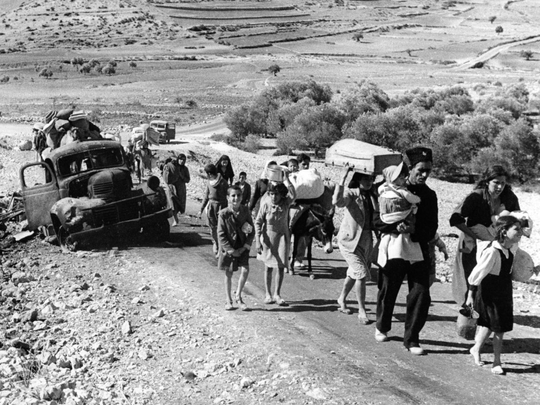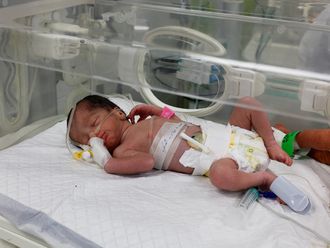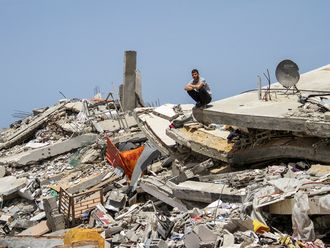
London: As Palestine’s Nakba concludes 70 years today, the brutal Israeli occupation and Jewish usurpation of Palestinian land continues unabated since 1947. MUSTAPHA KARKOUTI, IN LONDON, EXPLAINS
What is the Nakba?
Nakba is the Arabic word for ‘catastrophe or calamity’. The Nakba refers to the uprooting, expulsion and dispossession of 750,000 Palestinians from their homeland in historic Palestine during the period of 1947-1949. This criminal action was officially culminated by the declaration of the so-called ‘State of Israel’ on May 15, 1948.
The Nakba was the result of a deliberate policy of mass expulsion and ethnic cleansing aided by colonial powers, particularly the British mandate and various Zionist organisations in Europe including the 117-year-old international organisation, the Jewish National Fund (JNF).
“The Palestinian Nakba” in the words of a leading British Arabist is “the story of enduring, continuing loss and dispossession tragedy that has continued for 70 years, and one wonders how much longer it will last,” Director of the Council of Arab-British Understanding (CABU), Chris Doyle, told Gulf News.
“Still even in 2018, Palestinians lose land, homes and resources as well lives to an ever-expanding Israeli occupation,” Doyle said.
A Jewish homeland: The creation of a false narrative
Over a century ago, early Zionist organisations in Europe and in Palestine actively began preparing the ground to declare the birth of the state of Israel.
In the 1920s, the NJF was the leading European Jewish political movement established to infuse the religion of Judaism with nationalistic ideology. It coined the phrase “a land without a people for a people without a land”, deliberately denying the very existence of the indigenous population of Palestine.
After WWI, a victorious imperial Britain emerged and took control in Palestine. In 1917, its then-foreign secretary, Arthur Balfour, conveniently ignored the existence of Palestinians that constituted more than 90 per cent of the population at the time.
Jewish emigration and strategy of expulsion
A strategy was collectively in the making to kick out Palestinians who had lived on their land for generations and ensure that they would be barred from ever returning to Palestine. This was in order to make way for a massive emigration of Jews from Europe, Russia and the Arab world into Palestine.
At least 11 well-trained Jewish terrorist underground organisations were indiscriminately carrying out military campaigns to spread fear and chase Palestinians away from their homes and villages in the years leading up to 1948.
They committed hundreds of massacres against civilians in almost 200 villages over many years unhindered. The massacre that stands out in the nation’s memory is Deir Yassin, a Palestinian Arab village of roughly 400 people near Jerusalem.
Displacement in numbers
The State of Israel was created in 1948 over a land that only a year earlier had been a majority Palestinian population with a majority of Palestinian villages. Several Israeli NGOs have reasonably succeeded in documenting the tragedy of 1948 with the purpose of raising the Nakba to the awareness of the broad Jewish public.
Zochrot (Zakirat in Arabic), the Hebrew word for ‘memories’, is one of those that graphically established the huge demographic and geographic changes that had been made during the period. It listed the following statistics in the area on which Israel was founded:
In 1947, the population numbered 900,000 Palestinians and 600,000 Jews.
In 1949, the number of Palestinian fell to 150,000 and the Jews rose to 1,000,000.
These numbers demonstrate how Israel, by 1949 had forcibly expelled 750,000 Palestinians and totally erased nearly 500 Palestinian villages within two years.
These figures are well documented by the UN Refugees and Work Agency in the Near East (UNRWA) that was founded in December 1949
Conflicting narratives
Meanwhile, a decade later Yitzhak Rabin, another former Israeli prime minister, assassinated by an extremist Jew for signing the Oslo Accord with Palestine Liberation Organisation (PLO) in 1993, talked about his role in expelling non-Jewish Palestinians from their home in 1940s. Rabin, himself a Palestinian Jew, was a member of the Palmach Para troops, the elite force of the Haganah gang, admitted in his memoirs to leading military operations in Palestine to chase Palestinians out of their homes and villages under the orders from David Ben Gurion, Israel’s first prime minister, in 1948.
What happened to the Palestinians that fled in 1948?
With the absence of any effective Arab army to fight against this hugely-funded and politically aided Zionist aggression, the creation of Israel resulted in the mass expulsion of thousands of Christian and Muslim of Palestinians who fled to neighbouring countries. Their descendants have lived as refugees for 70 years.
Will these refugees ever be able to return to their homeland?
The right of return has been enshrined in a UN resolution which has been ignored by Israel and the US. However, with Israel’s powerful and well-funded army, the Palestinians have little to fight back with except the moral high ground which has been reflected in numerous UN resolutions supporting their rights and criticising Israeli violations of international law.
The United States, Israel’s chief backer, has been accused of being a biased broker, for a fair and just solution which is evident in the billions of dollars in aid it gives Israel annually.
As a result, on the ground a policy of ‘might is right’ has been implemented by Israel, with its continued usurpation of Palestinian land. It seems very unlikely given the current power balance that Palestinians will be given a fair and just solution.
However, this has not killed the dream of many Palestinians to return to their land.
Despite all the lies and deception, the fact that the Palestinian people have survived, indigenously (about 22 per cent of Israel’s population) and in their diaspora, “is a living testimony to their determination to regain their human rights, including their right to freedom and self-determination in their historic homeland,” Doyle said.












